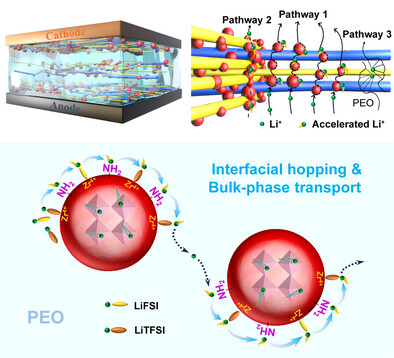具有多通道离子传输途径的MOF -离子液体结构聚合物电解质用于宽温度固态锂电池
IF 26.8
1区 材料科学
Q1 CHEMISTRY, MULTIDISCIPLINARY
引用次数: 0
摘要
离子液体增强的复合聚合物电解质(cpe)在界面兼容性和可加工性方面具有优势,是下一代固态锂金属电池的有希望的候选者。然而,它们在广泛温度范围内的应用一直受到机械稳健性和离子电导率之间的基本权衡的阻碍。为了克服这一限制,该研究设计了一种创新的基于聚环氧乙烷(PEO)的CPE架构来解耦这些特性。该结构利用氨基功能化金属有机框架(MOF)纳米颗粒封装和固定在PEO填充的电纺丝膜内,在宽温度下建立稳定的多通道离子通道。结合实验和计算研究表明,功能化的MOF使Li +能够在界面上快速跳跃,并且MOF约束的IL促进了体离子传输。这种多路径机制确保了Li +在−10至120°C范围内的高导电性和结构稳定性。此外,优化后的CPE有利于形成富liff的固体电解质界面相和无机为主的阴极电解质界面相,显著提高界面稳定性。因此,LiFePO4||锂电池表现出优异的可循环性,在3℃下循环1000次后仍保持96.8%的容量,并且在−10和120℃下都能稳定运行400多次。这些结果建立了一种新的策略来解耦CPEs机械性能和电化学性能之间的内在妥协。本文章由计算机程序翻译,如有差异,请以英文原文为准。

MOF‐Ionic Liquid Structured Polymer Electrolytes with Multi‐Channel Ion Transport Pathways for Wide‐Temperature Solid‐State Lithium Batteries
Composite polymer electrolytes (CPEs) enhanced with ionic liquids (ILs) are promising candidates for next‐generation solid‐state lithium metal batteries, offering advantages in interfacial compatibility and processability. However, their application across a broad temperature range has been hindered by a fundamental trade‐off between mechanical robustness and ionic conductivity. To overcome this limitation, the study designs an innovative poly(ethylene oxide) (PEO)‐based CPE architecture to decouple these properties. This architecture utilizes amino‐functionalized metal‐organic framework (MOF) nanoparticles to encapsulate and immobilize ILs within PEO‐filled electrospun membranes, establishing stable multi‐channel ion pathways across wide temperatures. Combined experimental and computational studies reveal that the functionalized MOF enables fast Li⁺ hopping at interfaces, and the MOF‐confined IL boosts bulk ion transport. This multi‐path mechanism ensures high Li⁺ conductivity and structural stability from −10 to 120 °C. Furthermore, the optimized CPE facilitates the formation of a LiF‐enriched solid electrolyte interphase and an inorganic‐dominated cathode electrolyte interphase, significantly enhancing interfacial stability. Consequently, LiFePO4 ||Li cells exhibit excellent cyclability, retaining 96.8% capacity after 1000 cycles at 3 C, and demonstrate stable operation for over 400 cycles at both −10 and 120 °C. These results establish a novel strategy for decoupling the intrinsic compromise between mechanical and electrochemical performance in CPEs.
求助全文
通过发布文献求助,成功后即可免费获取论文全文。
去求助
来源期刊

Advanced Materials
工程技术-材料科学:综合
CiteScore
43.00
自引率
4.10%
发文量
2182
审稿时长
2 months
期刊介绍:
Advanced Materials, one of the world's most prestigious journals and the foundation of the Advanced portfolio, is the home of choice for best-in-class materials science for more than 30 years. Following this fast-growing and interdisciplinary field, we are considering and publishing the most important discoveries on any and all materials from materials scientists, chemists, physicists, engineers as well as health and life scientists and bringing you the latest results and trends in modern materials-related research every week.
 求助内容:
求助内容: 应助结果提醒方式:
应助结果提醒方式:


